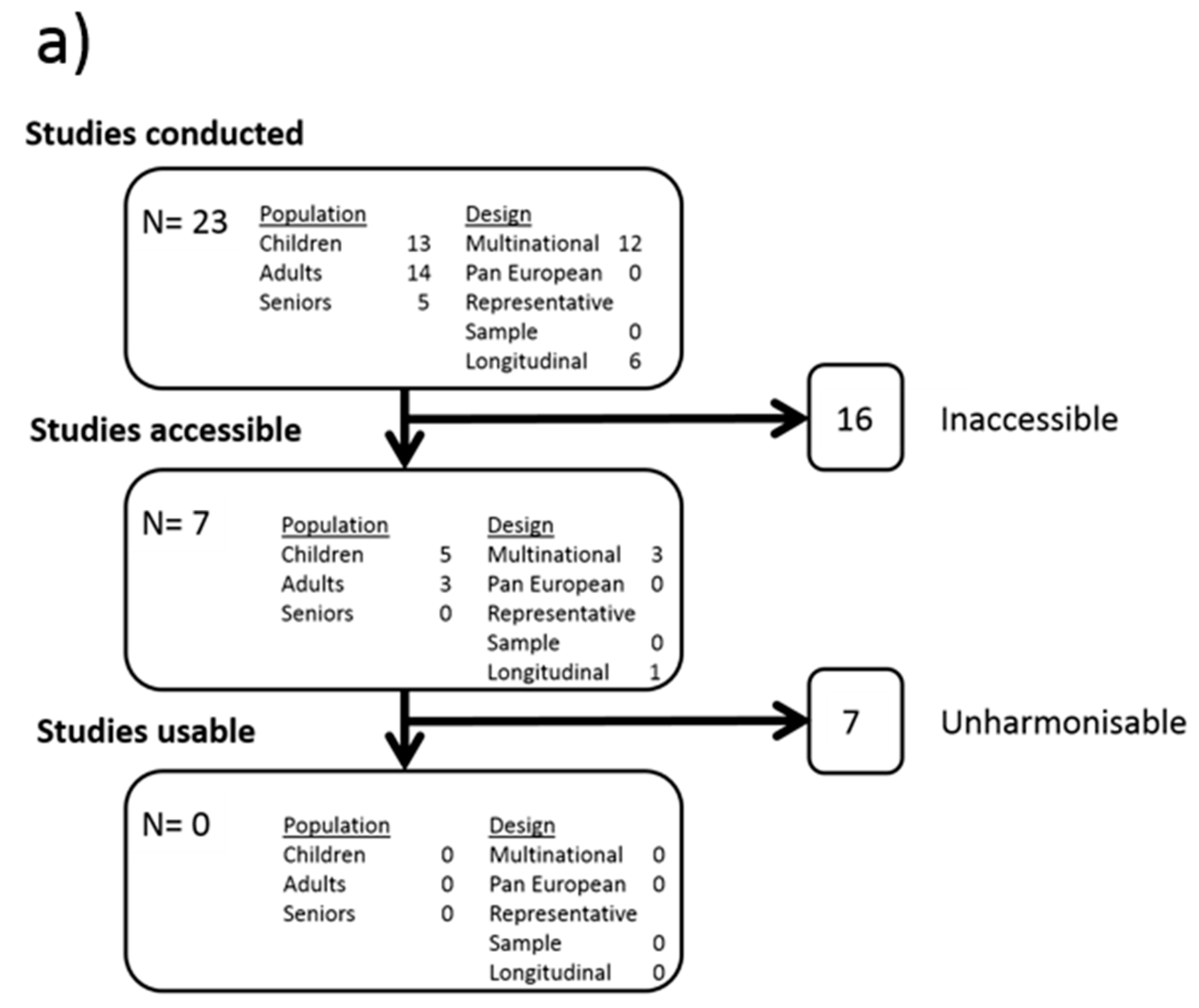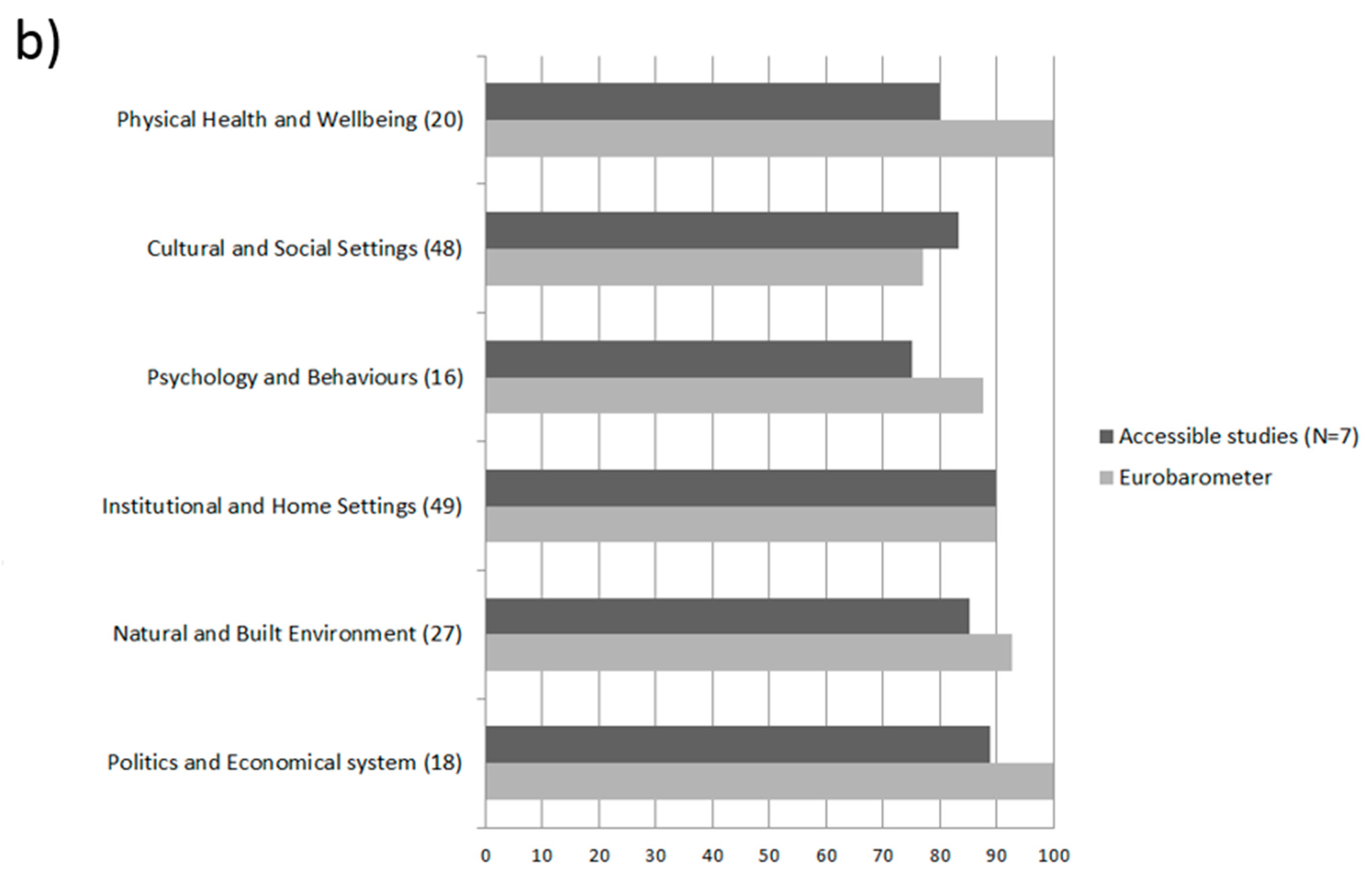Data on Determinants Are Needed to Curb the Sedentary Epidemic in Europe. Lessons Learnt from the DEDIPAC European Knowledge Hub
Abstract
:- 1
- School of Health Sciences, Faculty of Medicine and Health Sciences, University of East Anglia, Norwich, UK
- 2
- Co-Chair, Sedentary Behaviour Council, International Society for Physical Activity and Health
- 3
- Principal Fellow, Cancer Epidemiology and Intelligence Division, Cancer Council Victoria, Australia
- 4
- Honorary Principal Fellow, Centre for Epidemiology and Biostatistics, Melbourne School of Population and Global Health, The University of Melbourne, Australia
- 5
- Honorary Fellow, Physical Activity Laboratory, Baker Heart and Diabetes Institute, Australia
- 6
- Senior Investigator Scientist, MRC Epidemiology Unit, University of Cambridge, UK
1. The Problem
2. Current Evidence Base on the Determinants of Sedentary Behaviour
3. Framework
4. Existing Data Inventory and Analysis
5. Tackling the Sedentary Epidemic
6. Conclusions
Author Contributions
Funding
Conflicts of Interest
References
- Biswas, A.; Oh, P.I.; Faulkner, G.E.; Bajaj, R.R.; Silver, M.A.; Mitchell, M.S.; Alter, D.A. Sedentary time and its association with risk for disease incidence, mortality, and hospitalization in adults: A systematic review and meta-analysis. Ann. Intern. Med. 2015, 162, 123–132. [Google Scholar] [CrossRef] [PubMed]
- Ekelund, U.; Steene-Johannessen, J.; Brown, W.J. Does physical activity attenuate, or even eliminate, the detrimental association of sitting time with mortality? A harmonised meta-analysis of data from more than 1 million men and women. Lancet 2016, 388, 1302–1310. [Google Scholar] [CrossRef] [Green Version]
- Ng, S.W.; Popkin, B.M. Time use and physical activity: A shift away from movement across the globe. Obes. Rev. 2012, 13, 659–680. [Google Scholar] [CrossRef] [PubMed]
- Ding, D.; Lawson, K.D.; Kolbe-Alexander, T.L.; Finkelstein, E.A.; Katzmarzyk, P.T.; van Mechelen, W.; Pratt, M.; Executive, P.A.S. The economic burden of physical inactivity: A global analysis of major non-communicable diseases. Lancet 2016, 388, 1311–1324. [Google Scholar] [CrossRef]
- Lakerveld, J.; van der Ploeg, H.P.; Kroeze, W.; Ahrens, W.; Allais, O.; Andersen, L.F.; Cardon, G.; Capranica, L.; Chastin, S.; Donnelly, A.; et al. Towards the integration and development of a cross-european research network and infrastructure: The Determinants of Diet and Physical Activity (DEDIPAC) knowledge hub. Int. J. Behav. Nutr. Phys. Act. 2014, 11, 143. [Google Scholar] [CrossRef] [PubMed] [Green Version]
- Stierlin, A.S.; De Lepeleere, S.; Cardon, G.; Dargent-Molina, P.; Hoffmann, B.; Murphy, M.H.; Kennedy, A.; O’Donoghue, G.; Chastin, S.F.; De Craemer, M. A systematic review of determinants of sedentary behaviour in youth: A DEDIPAC-study. Int. J. Behav. Nutr. Phys. Act. 2015, 12, 133. [Google Scholar] [CrossRef] [PubMed] [Green Version]
- O’Donoghue, G.; Perchoux, C.; Mensah, K.; Lakerveld, J.; van der Ploeg, H.; Bernaards, C.; Chastin, S.F.M.; Simon, C.; O’Gorman, D.; Nazare, J.A.; et al. A systematic review of correlates of sedentary behaviour in adults aged 18–65 years: A socio-ecological approach. BMC Public Health 2016, 1, 163. [Google Scholar] [CrossRef] [PubMed]
- Chastin, S.F.M.; Buck, C.; Freiberger, E.; Murphy, M.; Brug, J.; Cardon, G.; O’Donoghue, G.; Pigeot, I.; Oppert, J.M.; Consortium, D. Systematic literature review of determinants of sedentary behaviour in older adults: A DEDIPAC study. Int. J. Behav. Nutr. Phys. Act. 2015, 12, 127. [Google Scholar] [CrossRef] [PubMed] [Green Version]
- Chastin, S.F.; De Craemer, M.; Lien, N.; Bernaards, C.; Buck, C.; Oppert, J.M.; Nazare, J.A.; Lakerveld, J.; O’Donoghue, G.; Holdsworth, M.; et al. The SOS-framework (systems of sedentary behaviours): An international transdisciplinary consensus framework for the study of determinants, research priorities and policy on sedentary behaviour across the life course: A DEDIPAC-study. Int. J. Behav. Nutr. Phys. Act. 2016, 13, 83. [Google Scholar] [CrossRef] [PubMed] [Green Version]
- Wilkinson, M.D.; Dumontier, M.; Aalbersberg, I.J.; Appleton, G.; Axton, M.; Baak, A.; Blomberg, N.; Boiten, J.W.; Santos, L.B.D.; Bourne, P.E.; et al. Comment: The fair guiding principles for scientific data management and stewardship. Sci. Data 2016, 3, 160018. [Google Scholar] [CrossRef] [PubMed] [Green Version]
- Chastin, S.F.M.; Dontje, M.L.; Skelton, D.A.; Cukic, I.; Shaw, R.J.; Gill, J.M.R.; Greig, C.A.; Gale, C.R.; Deary, I.J.; Der, G.; et al. Systematic comparative validation of self-report measures of sedentary time against an objective measure of postural sitting (activPAL). Int. J. Behav. Nutr. Phys. Act. 2018, 15, 21. [Google Scholar] [CrossRef] [PubMed]


© 2018 by the authors. Licensee MDPI, Basel, Switzerland. This article is an open access article distributed under the terms and conditions of the Creative Commons Attribution (CC BY) license (http://creativecommons.org/licenses/by/4.0/).
Share and Cite
De Craemer, M.; Chastin, S.; Ahrens, W.; Bernaards, C.; Brug, J.; Buck, C.; Cardon, G.; Capranica, L.; Dargent-Molina, P.; De Lepeleere, S.; et al. Data on Determinants Are Needed to Curb the Sedentary Epidemic in Europe. Lessons Learnt from the DEDIPAC European Knowledge Hub. Int. J. Environ. Res. Public Health 2018, 15, 1406. https://doi.org/10.3390/ijerph15071406
De Craemer M, Chastin S, Ahrens W, Bernaards C, Brug J, Buck C, Cardon G, Capranica L, Dargent-Molina P, De Lepeleere S, et al. Data on Determinants Are Needed to Curb the Sedentary Epidemic in Europe. Lessons Learnt from the DEDIPAC European Knowledge Hub. International Journal of Environmental Research and Public Health. 2018; 15(7):1406. https://doi.org/10.3390/ijerph15071406
Chicago/Turabian StyleDe Craemer, Marieke, Sebastien Chastin, Wolfgang Ahrens, Claire Bernaards, Johannes Brug, Christoph Buck, Greet Cardon, Laura Capranica, Patricia Dargent-Molina, Sara De Lepeleere, and et al. 2018. "Data on Determinants Are Needed to Curb the Sedentary Epidemic in Europe. Lessons Learnt from the DEDIPAC European Knowledge Hub" International Journal of Environmental Research and Public Health 15, no. 7: 1406. https://doi.org/10.3390/ijerph15071406





